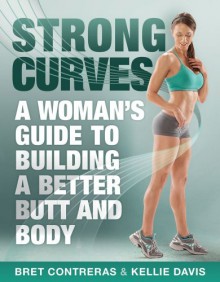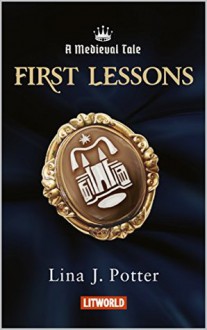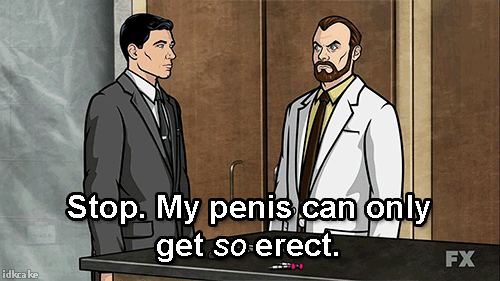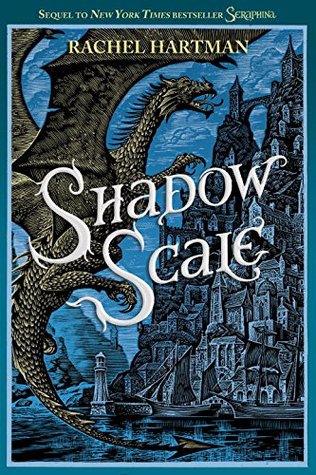
Note: I really feel conflicted about this book/program so I’ve sat on this review for over a month.
I’ve been weight lifting (dumbbells, kettlebells and barbell) for a little under a year.
At the time I started using the program in this book, my workouts consisted of a “body split.*” On Mondays, Wednesdays and Fridays I worked my lower body and back. On Tuesdays and Thursdays I worked my upper body.
The body split worked pretty well for me. I had very little upper body strength so I quickly became more defined in my chest and arms. But nothing was happening with the booty. *face palm* I was trying but I was clueless on how to get better. I was already deadlifting and squatting (but not very heavy).
Finally a friend suggested Bret Contreras (AKA The Glute Guy) and his book Strong Curves. She told me to check him out (and to add Bulgarian Split Squats to my lower body routine). I checked Brett Contreras’ website out. After reading a little I felt I found an answer to my lower body issues and I decided to try the program.
Formatting
I don’t recommend the ebook. The ebook format is NOT optimal for this type of reading [Strong Curves is more reference book than a straight read like a novel]. The organization of the ebook is rather atrocious. There’s no page numbers given as reference (or links) to the exercise instructions. There’s no index. There is a lot of equipment used in this program but there are no alternative exercises suggested (though the author says you should substitute exercises if necessary). The book has a lot of photos, graphs and charts…and on an ereader this means lots and lots of page turns. It also means a lot of searching as there are no page numbers listed with the exercises to help a reader find the exercise in the glossary. On Amazon reviews I saw that some readers created their own indexes with Excel.
I eventually purchased the hardcopy of Strong Curves. Best decision I made. The [majority of the] difficulties I had with the ebook were not present with the hardcopy. Each exercise photo has a page number that corresponds to the glossary. Each color photo of Kellie Davis performing exercises show a page number to the corresponding exercise in the glossary. The book is full color, 8 1/2″ x 11″ perfect bound. I had the same issues with alternative exercises – the authors suggests doing alternatives but never provides a suggested alternative (although there are alternatives pictured in the glossery). There’s still no index.
This book was NOT created to take to a gym in ebook or hardcopy format – it’s better to study at home/in private and then photocopy individual sheets if needed. To be honest, the book isn’t really good while working out at home since it’s perfect bound. I actually write out the exercises and stick it in my exercise diary for easy use and access.
Things I Learned
“Weak glues can cause your knees to cave in during a squat (valgus collapse), your posture to erode, or your lower back to start to ache when you go about daily activities.” — Chapter 3, page 23
Strong Curves discussed form quite a bit. Form is very important (poor form leads to injury) and the reader is constantly reminded of the importance of form throughout the book. Sadly, the authors do not give any suggested sites to peruse so the reader can see the exercise(s) in motion. This would become a problem for me, as I note later in this review.
Chapter 5 covers nutrition and diet. This was one of the more difficult chapters for me to absorb. Strong Curves stresses the need for a good diet comprised of whole foods but the authors go into great detail without really going into detail at all. Protein, dietary fats, and carbohydrates are all discussed – using industry terminology and very little layman language. There are convoluted equations and lots of lists provided to assist in creating a diet – it’s pretty complicated if you aren’t familiar with counting calories and macros. In order to program your own diet based upon the Strong Curves provided information – you will need to correctly calculate your macro-nutrients (after figuring out your total calories). Or you could use the really easy Fitocracy Macros app. Strong Curves recommends weekly (or at least “regular”) weigh-ins. The authors feel that this will help “keep [you] honest” regarding diet. I’m not a big fan of the scale but I did do “semi-regular” weigh-ins. I found it not to be all that helpful (but it went a long way in making me feel fat) since muscle is denser than fat.
Strong Curves did help me to find a lot of weak and/or unstable areas of my body. I’ve discovered my lower back probably kicks in when doing bridging activities due to weak hamstrings. I also learned about “Valgus Collapse.” Once I learned about it – I started to notice when my knees caved in more and more. (My PT suggests putting a resistance band around the lower thigh (snug but NOT tight) in order to help you notice any collapse.) I also learned that the hip thrust is not 100% possible for people with tight hip flexors – like me.
“When you plan your schedule, you will perform your strength workouts first. This ensures that you are using maximal effort with your strength programs, making your aerobic activity your secondary priority for energy demands.”
–Chapter 6, page 53
Speaking of warming up, Strong Curves covered that as well. The routine(s) given are a series of self-myofascial release (using a variety of different items) and basic stretching activities. I never did them, I prefer to warm up with low impact exercises. YMMV.
The Program
Strong Curves has four (4) preset programs – two full body programs with different experience/skill levels, one “at home” only program and one lower body only program. It also has instructions to make a customized program. The programs in the book are:
Strong Curves Twelve-Week Booty-ful Beginnings Program for Beginners
Strong Curves Twelve-Week Gluteal Goddess Program for Advanced Lifters
Twelve-Week Best Butt Bodyweight Program (At-Home)
Twelve-Week Gorgeous Glutes Program (lower body only)
I did the beginners program and I made it to week eleven (11) of the twelve (12) week plan. To my immense disappointment I was unable to complete the final week of the program due to injury.
“Most women can hip thrust more than they can squat and they can deadlift more than they can hip thrust.” –Chapter 8, page 74
The exercise plans are based around four week clusters (3 months total for each program) with each cluster consisting of 3 different sets of exercises. Each set of exercises are meant to be done on a different day and almost all of them are paired supersets. Supersets are “two or more different physical exercises performed back-to-back, without a period of rest between them. The exercises may employ the same muscle group, or opposing muscle groups.” While the workouts are created as paired supersets, the book suggests doing straight sets if working out in a commercial gym and [you] can’t reserve two pieces of equipment at a time.
Annoying Things
One of the things that annoyed me about the Strong Curves programming is the aerobic aspect of it. In that there is no aerobic component to this program. BUT the book states that optimum results would come from adding aerobic (or HIIT) exercises. Strong Curves suggests working out six days a week – 4 days lifting using the Strong Curves programming and 2 days of user defined cardio, leaving one day of rest per week. And that’s why this part annoys me. I paid for [what I thought was] a complete program. It should be complete. Don’t tell me to “do some cardio, too.” Make actual suggestions (or program it in!) to round out the program so it is complete.
Another issue that I consider MAJOR is the equipment used to create these programs. The sheer amount of differing equipment is overwhelming! The authors give multiple lists of equipment: The largest (and complete) list is a suggestion for the construction of a home gym. Then there are different lists: one at the beginning of each four (4) week cluster. For example, here’s a list of everything I needed to complete the Beginner’s Program (all 12 weeks):
Exercise mat
Flat bench
Dumbbells
Exercise box (may use flat bench or multiple aerobics steps if box is not available)
Cable lat pulldown machine (see Exercise Index for substitute exercises if training from home or if machine is not available)
45-degree back extension apparatus (see Exercise Index for substitute exercises if training from home or if apparatus is not available)
Seated cable row machine
Chin-up bar
Flat barbell bench
Barbell (may need plate weights and clips, too)
Table or support mechanism for bodyweight reverse hyperextensions
Swiss ball
Kettlebell
Hampton thick bar pad
Cable column
Squat rack
Band
That’s a shitton of equipment!!! For a beginner’s program! Thank goodness I have a semi-decent home gym as well as a commercial gym membership. Otherwise, I’d be more than a little discouraged. Some of the items listed I already had. Others I still don’t have. And I admit it…I only go to the commercial gym now and again. So I don’t do any of the exercises that require a cable machine of some type unless I can modify the exercise to use the resistance tubes I already own. And no, the book does NOT help with modifying exercises (as I’ve mentioned time and again). I’ve found most of my modifications doing online searches or talking to people at Fitocracy.
The biggest issue I’ve had was complexity. Strong Curves becomes progressively complicated and this was a problem. The book is written with one or two things assumed about the reader/user: A) that the user has been taught/already knows the proper form necessary for complicated strength moves or B) the user has access to a strength and conditioning coach who will teach the user the proper form. I think this is/could be a major turn off for some. Step-ups into reverse lunges is one of the biggest transgressions. This exercise is often referenced as one of the more difficult in discussions in the Strong Curves Fitocracy group. There are also complex barbell exercises like the Stiff Leg Barbell Good Morning. This exercise scared me somewhat – as the bar is placed behind the head before leaning forward. I decided not to load the bar with weights to be safe.
For me, lack of information about complicated moves has led to injury. *sigh* I’m rather upset about this, especially since Contreras hammered on the fact that any lower body injury will cause the glute muscles to shut down. The injury caused me to rethink my feelings toward the book.
Strong Curves was written by someone working on their PhD thesis and it reads that way. There’s a lot of complicated and technical sections to absorb and there’s a lot of information left out. I think the author assumes the user will automatically go to his website to absorb more information. The problem with this assumption is that the user has to know what to look for before she goes on a search – his site is massive.
Results
I forgot take before and after shots. I’ll try that next time.
I DO feel like I made progress. My booty is definitely stronger and rounder than previous.
I did not lose any weight with this program (scale wise). Over the time of the program I actually gained weight but a lot of it is muscle. The last time I was weighed at my doctor’s office I had lost 1% bodyfat. My body looks a little different. I’m smaller and/or tighter in some places and bigger in others. My arms have lost some definition from when I was doing the body splits. I also admit that I fell into the typical beginner’s trap: I started eating too much.
I like Strong Curves but it could use some improvements. There are things that I do and don’t like about Strong Curves but it’s still a great resource. I enjoyed the programming in this book – I’d love it even more if alternative exercises were clearly suggested and videos were referenced. I can say that I don’t feel that my money OR my time has been wasted. I do think I’ll come back to this book to continue with other one of the other programs in the future.
4.5 Stars – Programming Results – My bottom is certainly rounder and firmer.
2 Stars – not enough *detailed* information on the Hip Thrust, no links to videos for form checks, and no information on injuries or potential injuries.
3 Stars – complexity of the exercises and the extensive equipment list
3 Stars – book reads like someone writing their PhD thesis
3.125 Stars rounded up to 3.5 Stars
* A full body workout exercises the entire body with all muscles being stimulated in one workout. A split routine (body part split, training split, etc.) separates muscle groups to be worked in different workouts on different days (like doing legs on MWF and arms on T/T).


 Log in with Facebook
Log in with Facebook 

 It is common, but oft-misunderstood that she settled for Harry's bitch-ass. Girl please, Cybil was FAR too fly to settle down with someone whose gun skills were so... poorly.
It is common, but oft-misunderstood that she settled for Harry's bitch-ass. Girl please, Cybil was FAR too fly to settle down with someone whose gun skills were so... poorly.









